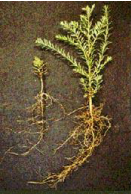Mycorrhizal Fungi
Click here to read the WOW Premium Mycorrhizal Analysis
What Mycorrhizal Fungi Are and A Few Interesting Facts
- There are two ways to manufacture commercial mycorrhizal fungi propagules, In- Vivo (“within the living.”) grown on a host plant and in soil substrate and In-Vitro (“in glass”) grown in a laboratory setting using artificial media and genetically modified roots. Our mycorrhizae is 100% grown In-Vivo and never contains any GMO’s. In-vivo mycorrhizae are exposed to the same environmental conditions as the host plant, which allows the biology to adapt to the local soil and climate. This can make them more effective at colonizing the roots of the host plant. In contrast, in-vitro mycorrhizae may not be as well adapted to the local environment, which can limit their effectiveness.
There are two main categories of mycorrhizae common to western rangelands in the United States.
Vesicular-arbuscular mycorrhizae or VAM. VAM is a type of endomycorrhizae (endo = inside), and is the most widespread of the mycorrhizae. These fungi actually reside inside the cells of the plant root. They’re typically found associated with most grasses, forbs, shrubs, and a few trees such as juniper. They are generalists, have only a few species, and are slow to disperse.
Ectomycorrhizae (ecto = outside) grow around the root and between the root cells, but unlike VAM, the fungus doesn’t actually penetrate the root cells. The fungus also forms a considerable mass in the soil surrounding the plant roots. The fruiting, or reproductive bodies, of these fungi are sometimes visible as something we all recognize— mushrooms! Ectomycorrhizae are commonly associated with forest trees of temperate regions. On rangelands, they are found in riparian areas (the places next to water), open woodlands, and shrub oak communities. They are host-specific, have many species, and can disperse far and quickly.
Not all fungi are mycorrhizal. There are also fungi that help decompose the organic matter in litter and soil. However, they play a lesser role than bacteria in this important process in semi-arid and arid rangeland soils.

VAM (stained blue) in sagebrush root cells


Ectomycorrhizae
Why Mycorrhizal Fungi Are Important
- Some plants are "mycorrhizal-obligate," meaning that they can’t survive to maturity without their fungal associate. Important mycorrhizal-obligate plants in western North America are sagebrush, bitterbrush, and some native bunchgrasses.
- Mycorrhizae are particularly important in assisting the host plant with the uptake of phosphorus and nitrogen, two nutrients vital to plant growth.
- Mycorrhizae actually increase the surface area associated with the plant root, which allows the plant to reach nutrients and water that might not be available otherwise. Put simply, mycorrhizae extends the plant’s reach, allowing it to get to more of what it needs to survive. That makes the plant stronger, especially during drought periods. Stronger individuals means that the community is more resilient to disturbance. Some mycorrhizae may even protect their host plant against unwanted pathogens.

Roodwood seedlings with (right) and without (left) mycorrhizae.

Pine seedling showing how mycorrhizal roots from one tree spread to inoculate other tree roots.
Click here to check out the White Page discussing Mycorrhiza Primer more in Depth!
This article was found on the Bureau of Land Management’s website. www.blm.gov


